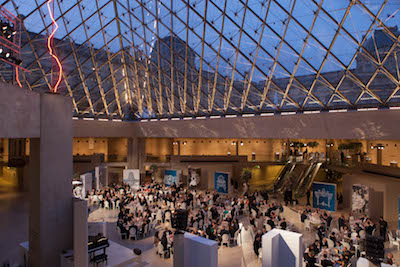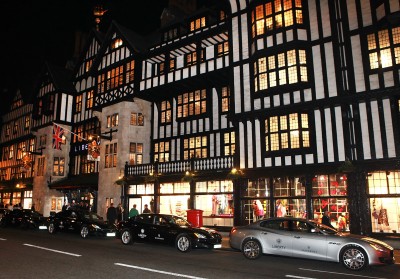 Image courtesy of LVMH
Image courtesy of LVMH
Offering the highest ROI of any marketing strategy, a successful event program must merge brand DNA with a strong understanding of target consumers’ passions, according to Wealth-X.
Wealth-X has prepared an Applied Intelligence white paper providing marketers with best practices for event strategies. With 84 percent of luxury marketers hosting events to reach UHNW individuals, understanding the fundamentals that can ensure the success of future outreach and underscore reasons why past events may have fallen short.
"Today, most brands practice what we call 'hope marketing,'" said David Friedman, president of wealth intelligence firm Wealth-X, New York. "Hope marketing is planning an event and creating an experience that a brand’s top clients 'can’t buy themselves.' That is the mantra.
"The reality is they could they just don’t want to make the effort in most cases. Then the marketing and client development teams sit around imagining what over-the-top event they can plan to get their top clients and their friends in the room," he said. "They hope that their clients comes and hope that they bring their friends and hope that those friends are actually prospects and hope that they have a reason to meet and then follow-up with those hopeful prospects.
"Its all based on hope. Then when they assess the ROI on the event, everyone does an 'executive belly rub' and feel good and perhaps randomly sold an item or two but there is no real data or strategy."
Wealth-X defines an UHNW as being those with more than $30 million in net assets.
VIP RSVPs
For the 62 percent that calculate ROI from their events, the most successful parties were product-centric, either launches, displays or educational. Even though events typically revolve around merchandise, the focus is usually more about making a connection (see story).
"Engaging the UHNW audience is challenging since they are immune to the traditional forms of advertising and getting above the noise can be almost impossible especially when it comes to this coveted wealth segment," Mr. Friedman said.
Making that connection is not as simple as it sounds. Wealth-X stresses the first step to a successful event is ensuring that the right people are in the room and that the host brand knows how to communicate with them during and after the occasion.
When staging an event, brands often get hung up on expressing their unique values and programming an experience that reflects their DNA.
Breguet event
The guest list often reflects VIP clients who are invited to bring along friends, who are from the same or higher income bracket. Additionally, brands often invite celebrities and influencers as a way to cull clients’ attention to their events, this way VIPs and their friends are more inclined to attend.
Wealth-X emphasizes that while this strategy may fill the room, it will cause sales associates to gravitate toward the established or prospective clients they are already familiar with. The risk of an embrace invite strategy also increases the probability that some in attendance are not of the target demographic to make a sizable donation or purchase.
To avoid falling into this trap, Wealth-X challenges brands to create a full strategy for events.
First, brands should define the segment or market to narrow down the event’s objective. This entails database analysis that identifies VIP clients as well as “low-hanging fruit” who have done business with the brand, but are not active participants.
Event outside Liberty London department store
Consumer analysis should be conducted on the individual level as all UHNWs have different passion points and interests.
Once the profile is narrowed down, a brand can go through potential guests to decide exactly whom to invite to a particular event. Wealth-X notes that for this part of planning brands should be as specific as possible.
Brands should strive for an intimate event experience rather than one that is based off a mass mailing with little connection to invited consumers.
The curated guest list should include three types of consumers: top clients familiar to a brand, those uncovered from the database and individuals connected to clients. The latter should not just be an unnamed “plus one,” but rather a known associate that would be a good fit for the brand’s objective.
Experience is paramount for UHNWs, so developing an event that will leave a lasting impression is important. UHNWs also want to leave an event with a feeling of exclusivity.
A brand should plan an event that is true to its codes, but also connects to attendees’ passions and interests.
During an event many brands tend to focus on the upper crust of their guest lists, which they often know better than the rest. But, this approach ends up neglecting others who have taken the time to attend.
Land Rover event for The Defender
Wealth-X states that the latter demographic should be more of a focus and it is these individuals that should be the subject of pre-event preparations. The events team should learn as much as possible about these individuals to create conversation and familiarity.
Lastly, a follow-up strategy is essential otherwise the event was a “useless exercise.”
Brand marketers should reach out to every attendee individually and have the infrastructure needed to then field responses.
In the digital age brands have become increasingly reliant on digital communications, but Wealth-X places importance on a phone call that melds a sincere thank you, pre-event intelligence, conversation from the event and reasons for future engagement.
Knowing the in-crowd
A fundamental necessity of an event is understanding the interests of target consumers whether it be automotives, yachting, art collection or other passions.
"Brands need to understand their own DNA but they also need to understand the DNA of their customers," Mr. Friedman said. "The fatal mistake in hope marketing is planning an event without really understanding the specific passion, hobbies and interests and then hoping that they will 'show up' for wine tasting or watches and scotch tasting.
"Data driven marketing events means mapping the affinities and passions of a brand’s clients, clustering them together and then designing events, sponsorships and marketing strategies that radiate and map to those specific clusters," he said.
"For example, many brands sponsor or do events at Art Basel in Miami, for example, assuming and 'hoping' that they can engage their target audience among the art collectors and 'hoping' that is of interest to their top existing clients."
Wealth-X has found that having an understanding of the social circles of wealthy consumers is an effective method to generate qualified referrals. In addition, as affluents increasingly become more receptive to experiential marketing, branded efforts that are injected into the social calendar, where UHNWs will likely be with family, friends and associates, will become more effective.
Mr. Friedman has spoken about the necessity among brands to understand their consumer, who they are, what they do and who their friends and family are in order to gain a full understanding of these individuals in order to effectively market. Luxury brands can learn from Wealth-X’s research on the ultra-high-net-worth individuals to create specific marketing strategy for the ultra-affluent (see story).
“[Another] anecdote to hope marketing is being proactive about the 'friends' your key clients bring to your events," Mr. Friedman said. "Referrals are a key engine of new client acquisition in the UHNW market but in like fashion to hope marketing, there is no data or strategy around the 'friends' being invited to these 'hope' marketing events.
"A best practice is to conduct what we at Wealth-X call a Future Client Map which segments the social graph of your top and key relationships by passions, hobbies and interests as well as net worth to ensure they are the right people to accompany your key clients to the event," he said.
"Then clustering should be done by geography and passions/hobbies/interests and this generates the blueprint for marketing themes and investments. This is the content that will connect with them and generate community, which leads to commerce."



